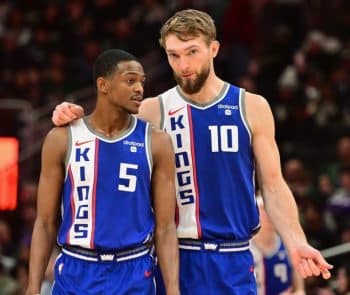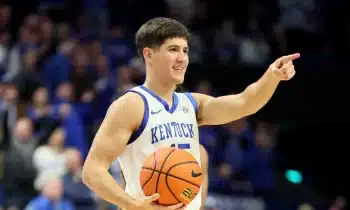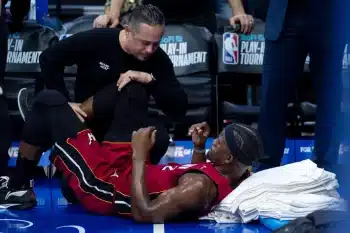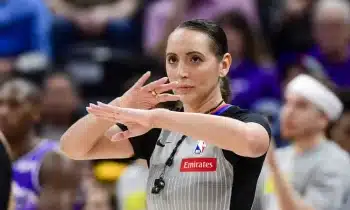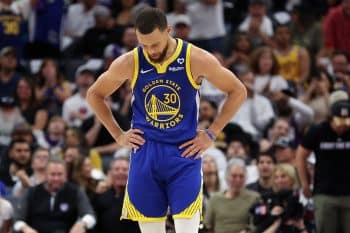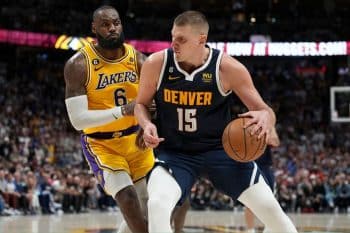NBA
NBA Sunday: The Dragic Dilemma

Back in July 2010, when Pat Riley walked into the room, he immediately and intentionally locked eyes with LeBron James.
He gave him a firm handshake, laid his rings out on the table and told James of his vision.
Championships, parades, dynastic potential—booty fit for a king.
After four years and four consecutive Eastern Conference Championships, James opted to return to Cleveland, which left Riley and his front office in a precarious position.
Without James, deep down inside, Riley knew that his team would be done competing for championships over the course of the near future. Dwyane Wade and Chris Bosh both became free agents with James, and although it was a forgone conclusion that Wade would end his career in Miami, the prevailing sentiment as it related to Bosh was that he would bolt Miami if James opted to.
Riley found himself and his franchise at a crossroads. Instead of pulling the plug and opting for an all-out rebuild, the HEAT first re-signed Bosh and recently traded for Goran Dragic. Both moves were done with the intention of preserving the HEAT’s status as a contender in the immediate future.
Before long, though, both moves may prove to have been mistakes for a team attempting to rise up as a contender, once again.
* * *
In the National Basketball Association, the worst place a team can find itself is in the middle—not good enough to win a championship, but not bad enough to have a top draft pick capable of turning the franchise around.
Things get even tougher for rebuilding teams when they saddle themselves with long-money contracts to free agents and/or trade future draft picks for players who will only marginally improve them in the short-term.
So the question that should be asked of Dragic is not whether or not he is a good player, but whether or not, for the HEAT, in the long term, he makes the difference between them being a team that is merely stuck in the middle versus one that has the ability to battle with and emerge victorious against the likes of the Cleveland Cavaliers, Chicago Bulls and Atlanta Hawks. At this point, even with Dragic, it may be more appropriate to ask whether the HEAT could outlast the Washington Wizards or Toronto Raptors in a playoff series.

Dragic is deceptively quick and is an accurate floor general who is an above average shooter and good finisher at the rim for his position. Like Steve Nash—a man to whom he once served as an understudy—Dragic is adept at creating space and getting to the basket. The gross majority of his shot conversions this season have come at the rim, and to anyone who watches him regularly, seeing him operate in the open floor is truly a pleasure.
There is no question that he is an above-average point guard who would have an opportunity to be an All-Star, especially playing in the Eastern Conference. But the fact is, now more than ever, winning in the NBA is as much about return on investment as it is accruing capable players.
And in a league where capable point guards seem to be a plentiful as Russell Westbrook shot attempts, one could easily make the case that paying a point guard a maximum salary is something that should only be done for those that are either the final piece to a championship or an MVP-caliber performer.
Sadly, Dragic is neither. And with Bosh already signed on for the long-term, the HEAT may have to seriously consider what Dragic is worth in terms of dollar value—something that will be made more difficult after forfeiting two future first-round draft picks for him at the February trade deadline.
* * *
In July 2014, with a four-year, $88 million offer on the table for Bosh to flee Miami and join Dwight Howard and James Harden in Houston, Riley ultimately opted to make Bosh an offer he could not refuse. Riley ended up going against his initial judgment and offering Bosh the maximum-allowable, five-year, $118 million offer.
As James packed his bags and his cars to head back home, Wade never even considered leaving his. Riley knew that and, when the proverbial fork in the road appeared, instead of pulling the plug on his “Big Three” era and opting for a full-out rebuild by allowing Bosh to go to Houston, Riley opted to attempt to reload and preserve the HEAT.
He did that for the sake of Wade.
A first-ballot Hall-of-Famer, a winner and a competitor with pride, Wade let it be known that he would have been unhappy and downright miserable playing out the string of a career and withering away in the twilight by playing for a 30-win team.
That is the sad fate that often awaits players and it is currently being seen in Los Angeles with Kobe Bryant and, to a lesser extent, with Carmelo Anthony in New York.
Riley feels that he owed Wade more than that, however, because it was Wade who did a lot of the leg work and seed planting with both James and Bosh and it is Wade who helped to deliver them to Riley in the first place.
Repaying Wade for that by having him play out the final three years of his career without James, without Bosh and for a perennial lottery team was one option. The other, which Riley chose, was to give Wade a puncher’s chance at competing as his career wanes down. That option began with Bosh and continued with Luol Deng.
Instead of bottoming out, the HEAT attempted to piece together a competitive roster by adding auxiliary pieces.
The acquisition of Dragic was a continuation.
All things considered, it just may not have been wise.
Like Anthony in New York, Bosh will turn 31 years old during the first year of his five-year maximum-salaried contract. In the final year of his contract, he will turn 35 years old and be earning $27 million.
Between now and then, his production will probably wane. From the beginning, signing Bosh to a five-year contract was questionable not because he is not a maximum-level talent, but because Father Time is undefeated.
The bigger issue for the HEAT, though, is that they have seemingly painted themselves into a corner with Dragic. Amongst the pieces the team traded away for him are two future first-round draft picks, which are the lifeblood of a franchise, and if there is one thing that the league has learned over the course of the past ten years, it is that you do not trade future picks for players who do not put your team over the top.
For the HEAT, Dragic does not do that and he especially does not do it if Bosh is not at 100 percent.
That the HEAT forfeited those two future first-rounders for Dragic has put Riley in the unenviable position of having an unrestricted free agent on his roster that he, for all intents and purposes, has no choice but to re-sign.
The Los Angeles Lakers are believed to be readying a four-year, maximum-salaried offer to Dragic once he hits the market in July. With an estimated salary cap of about $67 million, that would equate to somewhere in the neighborhood of a four-year, $66 million contract. That averages to about $16.5 million per year and if the HEAT want to re-sign Dragic this summer, if the Lakers are truly ready to pounce, a competitive offer will likely begin somewhere in the $15 million range.
Bosh is only a few weeks shy of his 31st birthday and is only in the first year of his maximum contract. Dragic will turn 29 years old in May. Will the Bosh-Dragic tandem be worth the combined $40 million the team would likely be paying them for the four seasons proceeding this one?
Even with the emergence of the impressive Hassan Whiteside and the continued contributions of Wade, that is a lot of money to pay to two players who, in and of themselves, are not MVP-caliber performers.
The saving grace for the HEAT may be the influx of money that is expected after the NBA signed a new television deal that will triple the league’s television revenue. The salary cap for the 2016-17 season could jump to about $78 million. That would give the HEAT increased flexibility to build around whatever core is in place at that time, but by then, Bosh and Dragic will be turning 33 years old and 31 years old, respectively.
Especially under the terms of the 2011 collective bargaining agreement, there is a direct correlation between roster flexibility and payrolls. Generally speaking, as payrolls increase, flexibility decreases.
When you’re married to a tandem such as James Harden and Dwight Howard, Stephen Curry and Klay Thompson or Russell Westbrook and Kevin Durant, the best course of action is to sign the checks now and figure the rest out later.
In the end, though, if the HEAT do indeed re-sign Dragic to a rich contract this summer, in the long run, they may be second-guessing the decision to trade for him in the first place.
* * *
As the 2014-15 regular season draws to a close, on March 1, the HEAT enter the final seven weeks of the regular season with the seventh seed in the Eastern Conference.
With Bosh ruled out for the remainder of the season, the HEAT are not promised a spot in the postseason. If they do get in, they would likely be pitted against the Hawks or Cavaliers in the first round.
Either way, they are not likely to pull off an upset. And that statement will probably be true of the HEAT over the next two years.
Dragic will hit the open market on July 1, and Riley and general manager Andy Elisburg would be wise to think long and hard about all of this before opting to re-sign Dragic at maximum-level money.
After trading two future first-round picks for him, though, the HEAT may not have a choice. For a player that does not turn your team into a contender, it is a decision that could have long-term ramifications.
